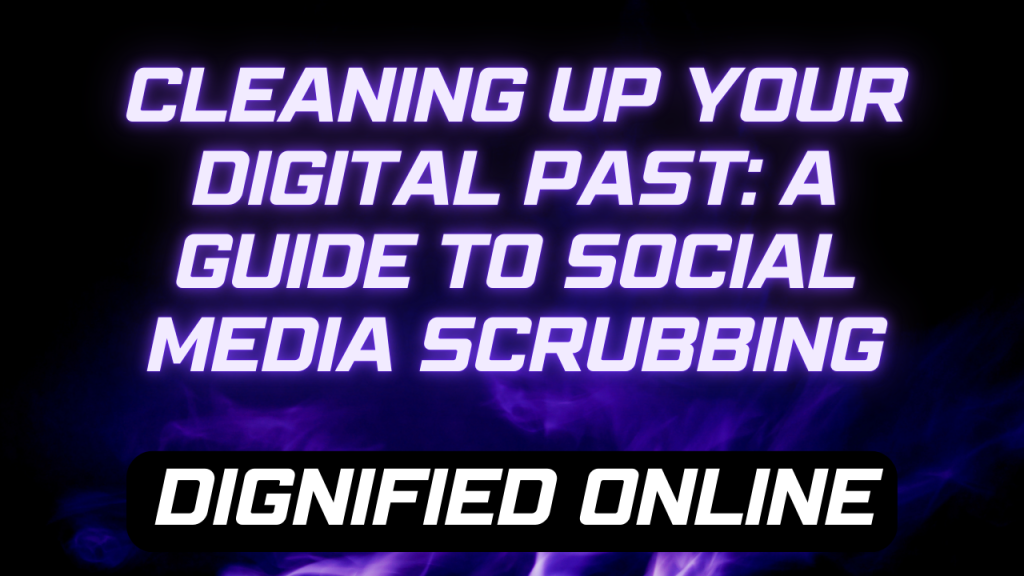In today’s hyperconnected world, your digital footprint is more than just a trail—it’s your public persona. Whether you’re applying for a job, running for office, or simply trying to maintain a professional presence, the internet has a long memory. That embarrassing Facebook post from 2010? Still searchable. A controversial tweet from your college days? A few keystrokes away.
Fortunately, cleaning up your digital past isn’t just possible—it’s increasingly necessary. Enter social media scrubbing: the process of reviewing, editing, and removing online content that may no longer reflect who you are today. In this guide, we’ll walk you through the steps of reclaiming your online reputation, with expert insights from Dignified Online, a leading online personal online reputation management firm.
Why Your Digital Past Matters
Employers, clients, and even dates often look you up online before forming a first impression. According to a 2024 survey by CareerBuilder, over 70% of employers use social media to screen candidates during the hiring process. What they find can tip the scales in your favor—or eliminate you from the running.
Old posts, insensitive jokes, or outdated opinions can resurface at the worst possible time. While people grow and evolve, the internet doesn’t forget unless you make it.
That’s where social media scrubbing comes in.
Step 1: Audit Your Online Presence
The first step is to find out what’s out there. Start by Googling yourself. Use quotation marks for more accurate results—e.g., “John Doe” + Twitter. Look beyond just your main accounts. Check photo tags, forum posts, Reddit activity, blogs, and even comment sections.
Dignified Online recommends creating a checklist of platforms where you’ve had accounts or published content in the past. This includes:
- Facebook
- Twitter/X
- Instagram
- LinkedIn
- YouTube
- TikTok
- Reddit
- Tumblr
- Personal blogs or websites
Be thorough. Many people are surprised by how much they’ve forgotten or overlooked.
Step 2: Review and Evaluate Content
Next, go through your accounts post by post. Ask yourself:
- Is this content potentially offensive or controversial?
- Does it misrepresent who I am today?
- Could it be misinterpreted out of context?
Dignified Online suggests using the “grandma test”: if you wouldn’t want your grandmother (or future employer) to see it, consider removing or archiving it.
Use tools to make this easier:
- TweetDelete or TweetEraser: bulk-delete old tweets.
- Jumbo Privacy: manages privacy settings and deletes content from multiple platforms.
- Facebook Activity Log: allows you to review posts, likes, and comments chronologically.
If you’re overwhelmed, Dignified Online offers personalized audits and cleanup strategies to help you tackle even the most complex digital histories.
Step 3: Delete or Edit Problematic Content
When it comes to problematic posts, deletion is often the best option. If you’re worried about erasing too much, some platforms let you archive content instead. That way, it’s hidden from public view but not lost forever.
For content you can’t delete—like third-party blog posts or shared photos—consider reaching out to the original posters to request removal. Dignified Online can assist with takedown requests and negotiate with content hosts when necessary.
Remember, screenshots live forever. While scrubbing can’t erase every trace, it dramatically reduces the chances of damaging content resurfacing.
Step 4: Lock Down Your Privacy Settings
Once you’ve cleaned up your content, prevent new issues by tightening your privacy settings. Make sure only approved followers can see your posts, especially on personal platforms like Instagram or Facebook.
Platforms are always updating their privacy policies. Dignified Online offers ongoing monitoring services to ensure your settings stay current and effective.
Step 5: Build a Positive Digital Presence
Scrubbing your digital past is only half the battle. The next step is shaping the narrative. Create and share content that reflects your current values, goals, and professionalism.
Ideas include:
- Publishing thought leadership articles on LinkedIn
- Sharing industry insights or accomplishments
- Starting a blog or portfolio
- Engaging in charitable or advocacy-related content
Dignified Online emphasizes the importance of proactive reputation building. Their team helps clients not just clean up digital messes, but create a compelling, authentic online presence moving forward.
Final Thoughts
Your digital history doesn’t have to define you, but it can affect you. Taking the time to audit, clean, and curate your online presence is an investment in your personal and professional future.
With tools, discipline, and a little help from experts like Dignified Online, you can take control of your online identity—and ensure it reflects who you truly are today.

